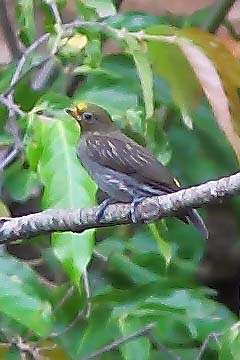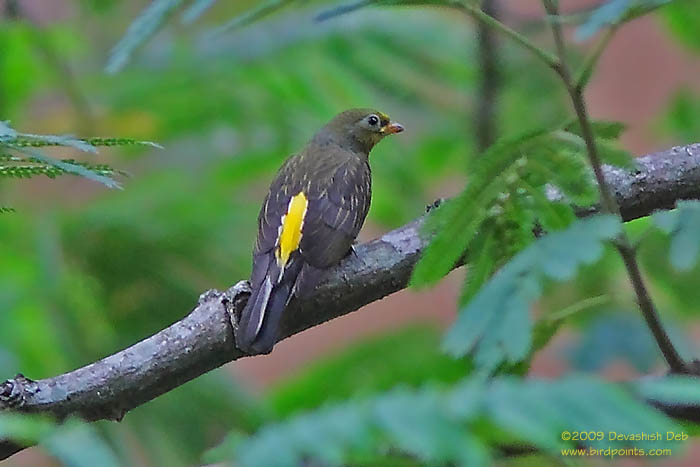 Historical
Historical
Original description:
Notes on various Indian and Malayan Birds, with Descriptions of
some presumed new Species. By Edward Blyth, Curator to the Museum
of the Asiatic Society.
5. Indicator xanthonotus, Nobis. (Golden-Backed Honeyguide). The
discovery of this species upon the Himalaya is of some interest,
as all its congeners heretofore known are inhabitants of Africa
only. Structure typical; length of a female 5 7/8, or probably 6
inches when recent; of wing from bend 3 3/8 inches; and tail 2 1/4
inches; bill from forehead 1/4 inch, and above 7/16 inch from gape;
tarse 1/2 inch; 2nd and 3rd quills equal and longest, the 1st and
4th a little shorter, and also equal; outermost pair of tail feathers
3/4 inch shorter, and penultimate pair 1/4 inch shorter, than the
rest, which latter are subequal; bill short and Finch-like, of a
triangular shape viewed from above, the ridge of the upper mandible
nearly obsolete, and its outline much curved; that of the lower
mandible less so. Forehead and lower part of the cheeks golden-yellow;
throat tinged with the same; crown and back of the neck dull olive-green,
as also the front of the neck, which is slightly tinged with yellow;
breast dusky-ash, the middle of each feather somewhat darker; belly
and thighs albescent, with a medial dusky streak to each plume;
lower tail coverts and above the tibiae dull black, with lateral
whitish margins; wings, scapularies, and interscapularies, dusky-black,
laterally margined with yellowish olive-green, obsolete on the outer
primaries, and the tertiaries margined on their inner webs with
white; tail and its upper coverts black, the uropygials and largest
medial pair of coverts edged on the inner web with grey, and the
small external pair of tail-feathers obliquely marked with whitish
at the tip; broad medial line along the rump bright golden-yellow,
changing to fine sulphur-yellow on the back under the interscapularies,
where the feathers are discomposed, silky, and hair-like, somewhat
resembling those of the centre of the crest of a typical Regulus,
but straighter and less downy; sides of the rump, bordering the
broad yellow stripe, black; and the wings underneath whitish tinged
with yellow, the feathers of downy texture: beak horny-brown, the
lower mandible paler; and legs apparently dark greenish. From Darjee1ing,
where stated to be very rare.
The affinities of this genus I have long considered to be with the
Woodpeckers, and not with the Cuckoos: their feet are formed exactly
as in the former group, not as in the latter; and they are accordingly
known to climb the boles of trees, in the cavities of which they
deposit numerous shining white eggs, wherein also they resemble
the Woodpeckers. I am unacquainted with the conformation of their
soft parts, further than that the traveller Bruce informs us, of
his "Bee Cuckoo," (Appendix to 'Travels to discover the
source of the Nile,' v. 179), that "the tongue is sharp-pointed,
can be drawn to almost half its length out of the mouth beyond the
point of the beak, and is very flexible," a statement which
1 did not remark until long after I had arrived at the opinion here
expressed. If my view be correct, it will probably be further confirmed
by the stomach proving to have its muscular coat considerably more
developed than in the Cuckoos; by the absence of coeca, as in the
Woodpeckers (normally*), these existing in all the Cuckoo tribe
which I have examined; and by the sternal apparatus, the form of
which is very different in the Woodpeckers and Wryneck from what
it is in the Cuckoos. The Barbets (Bucco) are quite distinct from
either, and more nearly allied in internal conformation to the South
American group of Toucans (Ramphastidae), which they even resemble
in the peculiar character of having short imperfect clavicles; while
the African group of Touracos (Musophagidiae), also allied, is remarkable
for having the c1avicles fully deve1oped, but permanently joined
together by cartilage only to constitute the furcula, as I have
observed in three different species.

 Historical
Historical